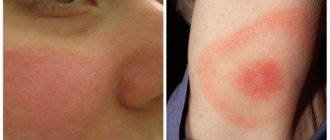Local therapist
Serebryakova
Oksana Evgenievna
Experience 28 years
Local therapist, candidate of medical sciences, member of the Russian Scientific Medical Society of Therapists
Make an appointment
The patient's condition is considered febrile if the body temperature rises above 37.2°C. This condition is not an independent disease, but is regarded as a sign of a serious pathology - an inflammatory process, infection, oncology. Less commonly, body temperature rises when taking certain medications and during heat stroke. Also, the temperature can fluctuate around the specified value during the day - decrease at night during sleep and increase in the evening due to intense exercise. For a healthy person, the range of daily fluctuations usually does not exceed 0.6°C.
Classification of fever
Depending on the level of body temperature, the following method of classifying fever is used:
- subfebrile temperature within 37.2 - 37.9°);
- febrile temperature at 38.0 – 38.9°C;
- pyretic temperature at 39.0 – 40.9 °C;
- hyperpyretic temperature starts at 41°C.
Attempts to cope with the rise in temperature are selected depending on its level. For low-grade fever, intervention is not recommended. The exception is pathology, when even a slight increase in temperature causes significant inconvenience to the patient. As the parameter increases, measures must be taken to stabilize it. Moreover, in the overwhelming majority of cases, the symptoms of fever indicate a serious problem in the body, to which it reacts by attempting to destroy the cause through high temperature or defeat it through the production of antibodies. Even if the temperature has been reduced, it is necessary to seek medical help and undergo the recommended diagnostics to clarify the cause of the fever and the immune response.
Fever in children, causes
Fever is a protective-adaptive reaction of the body to the influence of pathogenic factors
Fever is a protective-adaptive reaction of the body to the influence of pathogenic factors (viruses, bacterial infection, immune complexes, etc.), the most important manifestation of which is the restructuring of thermoregulation to maintain a higher than normal level of heat content and a higher body temperature.
Other important manifestations of fever are increased immune response of the body, stimulation of the bactericidal activity of polymorphonuclear leukocytes, increased production of interferon by fibroblasts during certain viral infections, as well as stimulation of other body defense mechanisms that prevent the proliferation of many microorganisms and contribute to their death.
In addition, fever is important as an alarm signal for other body systems, indicating the presence of a pathological process in it.
In some cases, fever may not be accompanied by an increase in body temperature.
The outcomes of infectious diseases accompanied by an increase in body temperature are always better than those occurring without an increase in body temperature or with its artificial pharmacological reduction (use of antipyretics).
Hyperthermia, hyperthermic state of a child, children
An increase in body temperature during fever can play an adaptive role only when it rises to a certain limit - 40-41 degrees C. With high hyperthermia , an increase in the intensity of metabolic processes is observed, the tissue need for oxygen increases significantly, and the intensification of blood flow increases to remove a large amount of heat from the body tissues to its surface. All this leads to increased stress on the respiratory and cardiovascular systems. Increased metabolic processes during hyperthermia are accompanied by the threat of acidosis, impaired water-salt metabolism, and depletion of energy resources, which is most dangerous for the function of the nervous system, myocardium, and kidneys. First of all, the functions of the central nervous system are affected, which is often manifested by the development of convulsive syndrome - febrile seizures (especially in young children with perinatal damage to the central nervous system). At the time of convulsions, respiratory arrest may occur, leading to the death of the patient. In a hyperthermic state, cerebral edema may develop, when the child’s condition sharply worsens, depression of the central nervous system increases, heart rhythm disturbances occur, and blood pressure decreases. The hyperthermic state itself can be fatal due to the development of energy depletion, intravascular coagulation and cerebral edema.
Depending on the magnitude of the rise in body temperature, fever is divided into subfebrile (37-38 degrees C), moderate (38.1-39 degrees C), high hyperthermia (39.1-41 degrees C), hyperpyretic (over 41 degrees C); according to the duration of the increase - ephemeral (from several hours to 2 days), acute (up to 15 days), subacute (up to 45 days), chronic (over 45 days); According to the type of temperature curve, constant, remitting, intermittent, hectic, relapsing, undulating and irregular fevers are distinguished.
Causes of fever in children. Infectious, non-infectious
All causes of fever can be divided into infectious and non-infectious. In temperate and cold climates, it is more often associated with ARVI, and in hot climates - with intestinal infections.
Infectious fevers in children are extremely numerous
Any infections (bacterial, viral, mycoplasma, chlamydial, parasitic, fungal), as well as the administration of vaccines (pertussis - whooping cough vaccination for children, children's medical, measles, influenza, etc.) can cause fever. In cold and temperate climates, these are acute respiratory and other viral infections. In regions with hot climates, intestinal infections are most common. The causative agents of infectious diseases enter the child’s body through the respiratory tract, digestive tract or parenterally. Infections such as cytomegalovirus, herpes, enterovirus, chlamydia, toxoplasma, and some others can be transmitted to a child in utero or intrapartum (affect young children). Flu vaccination - medical.
Fever in a child, children most often occurs with infectious diseases
In clinical practice, fever is most often encountered in infectious diseases. This, in particular, is reflected in the fact that many infections are called fevers (hemorrhagic, yellow, etc.). Only some infectious diseases occur without an increase in body temperature - cholera, botulism. Fever during infections is considered the main manifestation of the general toxic syndrome. Its pathogenesis is associated with the intake of exogenous pyrogens into the patient’s body and the formation of endogenous pyrogens. Exogenous pyrogens are a thermostable complex of polysaccharides with lipids, contained in the structure of many bacterial cells. Endogenous pyrogens are released by granulocytes and macrophages upon contact with pathogens. Endotoxins from gram-negative bacteria have the greatest pyrogenic effect. The point of action of pyrogens is the thermoregulation centers located in the hypothalamus. Moreover, the reaction to them is ambiguous, for example, against the background of hyperthyroidism it is increased, and with hypothyroidism, on the contrary, it is decreased. In the first stage of fever, which corresponds to a rapid increase in temperature, heat generation prevails over heat transfer. In this case, chills of varying intensity occur - a feeling of cold at high body temperature, muscle tremors, “goose bumps”. The second stage is characterized by stabilization of temperature at high levels, establishing a balance between the formation and loss of heat. In the third stage, the temperature decreases. During this phase, heat transfer mechanisms predominate. Due to the expansion of peripheral vessels, the pallor of the skin gives way to hyperemia, and profuse sweating appears. A rapid decrease, within one day or several hours, of a long-term high fever to normal levels is called a critical drop in temperature (with lobar pneumonia, sudden exanthema, etc.). With such a critical decrease in temperature, the child is at risk of excessive loss of chlorides - a “chloride crisis.”
Fever in a child. Correct assessment of causes
The variety of causes of fever confirms its ambiguity. The degree of temperature increase does not always reflect the severity of the disease. Thus, with brucellosis, tuberculosis (Mantoux test in children - medical), patients often remain in satisfactory health at a temperature of 38-39 degrees C.
It is known that when body temperature rises, the number of heart contractions increases. However, this correspondence manifests itself differently in different diseases. Thus, the classic course of typhoid fever is characterized by a certain lag in the pulse rate from the degree of temperature increase (relative bradycardia).
Therefore, it is advisable to focus on the combination of fever with other symptoms.
Persistent fever in a child, children
The temperature is high (exceeds 39 degrees C), with daily fluctuations of less than 1 degree C. It occurs without chills, profuse sweating, the skin is hot, dry, the underwear is not moisturized. This temperature is typical for lobar pneumonia, erysipelas, classic typhoid fever, and typhus.
Remitting fever in a child, children
The degree of temperature increase may vary. Daily fluctuations are 1-2 degrees C, not reaching normal numbers. Chilling is typical. During the phase of decreasing temperature, sweating is observed. Typical for brucellosis, bronchopneumonia, rheumatism, viral diseases, etc.
Intermittent fever in a child, children
It is characterized by a regular alternation of temperature increases with a range of several degrees, often to a high level with periods of normal or subnormal temperature (1-2 days). A rise in temperature is accompanied by chills and fever; a fall is accompanied by profuse sweat. It should be borne in mind that sometimes the intermittent type of fever is not immediately established. In the first days of the illness, it may be preceded by a so-called initial fever of a constant or irregular type. Typical for malaria, pyelonephritis, pleurisy, sepsis, etc.
Hectic fever in a child, children
The daily temperature range is particularly large, reaching 3-4 degrees C with a drop to normal or subnormal levels (below 36 degrees C). Characterized by severe chills and profuse sweats. Registered for sepsis, tuberculosis.
Relapsing fever in a child, children
Characterized by alternating periods of high, constant fever for 2-7 days. with fever-free periods of the same duration. The temperature drops critically with profuse sweating. Typical for relapsing fever.
Abnormal fever in a child, children
It occurs with various irregular temperature fluctuations. Chilling and sweating are typical. Occurs in many infections, in particular in sporadic typhoid fever.
Undulating (undulating) fever in a child, children
It is characterized by smooth rises and falls in body temperature with normal values in the intervals between rises in temperature (some forms of lymphogranulomatosis and malignant tumors, brucellosis).
In most cases, the cause of the fever becomes clear when symptoms typical of a particular infection appear
In most cases, the cause of the fever becomes clear when symptoms typical of a particular infection appear, or the temperature normalizes on its own after a few days. In cases of acute fever of unknown etiology, increased attention from the doctor, careful collection of anamnesis, and repeated examination of the child are required. The longer a child has a fever without characteristic symptoms of a particular infection, the less likely it is to have the latter.
Fever of non-infectious origin in a child, children
Fevers of non-infectious origin are quite numerous; the temperature rise in them rarely exceeds 38-38.5 degrees C, and they often have age-related characteristics.
An increase in temperature is observed in allergic and rheumatic diseases, vasculitis, immune disorders, oncological and hematological, endocrine diseases (pediatric endocrinologist at the Markushka clinic - consultations), poisoning and insect bites.
Consultation with a children's allergist at the Markushka polyclinic.
The causes of non-infectious fever can be medications, some metabolic diseases, hereditary factors, iron deficiency anemia, and extensive skin lesions.
Fever can be caused by increased muscle work and occurs in active, well-fed children. Post-traumatic fever is a resorptive fever with large hematomas or after surgery. Consultation with a pediatric surgeon at the Markushka polyclinic.
Constitutional fever in children
Constitutional fever can be quite constant and can last for months; the temperature rises monotonously up to 38 degrees C, especially during periods of increased growth (“growing fever”). At the same time, the child’s well-being practically does not deteriorate; the basic metabolism does not change. Body temperature may increase after screaming or intense physical activity and usually returns to normal after a short rest (30 minutes - 1 hour); in the summer months the temperature is normal.
A type of constitutional fever is an increase in temperature that occurs during certain experiences (fear, excitement, etc.). Psychogenic fever can be caused by intense stress (consultation with a child psychologist - Markushka clinic). One should be careful against the unreasonably frequent diagnosis of teething as a cause of fever, since it is known that in 99% of cases, an increase in temperature in children during this period is due to other reasons.
Cerebral hyperthermia (neurogenic fever) in children
Thermoregulation disturbances can be observed in acute and chronic diseases of the central nervous system. High body temperature is usually permanent. The general condition of the child is practically not disturbed. Cardiac activity indicators increase slightly and do not correspond to body temperature, which can reach 41-43 °C. The duration of the fever (months and even years) indicates its non-infectious nature.
Low-grade fever in a child, children
The greatest difficulty in diagnosis is caused by fever of unknown etiology, which is characterized by an increase in body temperature to 38.3 degrees C or more for 3 weeks. The most common causes of low-grade fever are focal infections of different localization (chronic tonsillitis, cholecystitis, gynecological diseases, pyelitis), tuberculosis, rheumatism, infectious-allergic myocarditis.
Hyperthermic syndrome in a child, children
Hyperthermia syndrome (HS) is a sharp increase in body temperature above 41 degrees C with impaired thermoregulation, causing disorders of the cardiovascular and central nervous systems, which are expressed in impaired consciousness and the appearance of symptoms of cerebral edema. HS develops due to a mismatch between the mechanisms of heat transfer and heat generation. This process is initiated by a number of biologically active substances formed during the body’s inflammatory response. With hyperthermia, oxygen consumption increases significantly, carbohydrate metabolism is disrupted, and the level of energy substances sharply decreases. In some cases, hyperthermic syndrome develops as a result of severe water deficiency dehydration, hyperthyroid crisis, or under the influence of certain medications. HS is observed mainly in young children with damage to the nervous system. Often accompanied by convulsions, anxiety, and a high-pitched scream.
Malignant hyperthermia in children
A group of hereditary diseases characterized by a sharp increase in temperature to 39-42 degrees C in response to the administration of inhalation anesthetics, as well as muscle relaxants, caffeine, cardiac glycosides, etc. It is hereditary in nature and is caused by enzymatic abnormalities of muscle cell membranes. Malignant hyperthermia requires intensive treatment.
Symptoms
With a slight increase in temperature, a person does not feel any discomfort and continues to lead his usual lifestyle. Rarely, there may be a feeling of discomfort due to temperature differences and a feeling of heaviness in the head area. When the temperature rises to 38.0 °C or more, characteristic “feverish” symptoms appear:
- redness of the skin of the face and body;
- inflamed eyes, caused by increased tear production;
- intense sweating associated with the body’s attempt to reduce the increased temperature;
- headache;
- aches in muscles and joints;
- decreased appetite;
- rapid breathing;
- drowsiness, immobility.
Children may experience a different course of the febrile process. “Red” fever is characterized by a slight deterioration in the condition, maintaining a comfortable temperature of the extremities and relatively stable health. With “white” fever, the child becomes lethargic, his skin turns pale and acquires a bluish tint, the pulse becomes faster, and blood pressure is higher.
Diagnostics
You can check your body temperature by measuring it with a mercury or electronic medical thermometer. It is placed in the armpit so that the shoulder fits tightly to the chest and a sealed space is maintained inside the armpit. In children and weakened patients, the hand with the thermometer should be held. The measurement duration is about 10 minutes. When assessing the actual indicator, you should focus on the level of 36.4-37.2 ° C - a temperature in the specified range is considered normal.
When measuring temperature in young children, use a special rectal thermometer designed to measure body temperature through the anus. However, this method has several contraindications. These are anal fissures, pronounced hemorrhoids and inflammation of the rectum, which excludes any additional trauma to the mucous membrane. The measurement is taken with the patient positioned on his side, with his knees pressed to his chest. The thermometer is inserted into the anus so that the measuring tip goes completely inside. To obtain the desired parameter, 2-3 minutes are enough, and the range of 37.1–37.9 ° C is considered normal.
An oral method of measuring temperature, for which a safe electronic thermometer is used, is considered acceptable. The normal variant here is the range of 36.7 -37.4°C. However, the data may be distorted due to the patient's recent consumption of hot or cold foods and drinks.
Establishing the fact of a febrile state is only part of the diagnostic measures. The doctor needs to find out what caused the increase in body temperature. For a more precise diagnosis of fever, the patient is referred to:
- radiography;
- ultrasonography;
- blood and urine tests;
- other diagnostic procedures.
If the temperature is low
It happens that with ARVI, the thermometer freezes at below 360C. How to feel about this and what to do? Hypothermia can be caused by excessive sweating. You need to wipe your armpit dry and measure your temperature again. A temperature reaction that is inadequate to the general condition often occurs in older people, pregnant women, and patients with severe concomitant diseases and endocrine pathologies. Sometimes the cause of hypothermia is the abuse of antipyretic drugs, so you should always strictly follow the instructions for taking the drug. Even if the temperature is normal, you should not ignore the symptoms of ARVI: the less nasal congestion and the less frequent sneezing, the less viruses will spread. The combined drug TheraFlu for colds and flu has antipyretic, anti-inflammatory, decongestant, analgesic and antiallergic effects, which helps improve well-being5 even at normal and low body temperature. In any case, if cold symptoms appear, you should consult a doctor. After all, only a specialist can adequately assess the condition and symptoms of the disease and select the necessary treatment.
Treatment options for fever
Stabilization of body temperature and treatment of fever is carried out using the following methods:
- Taking antipyretic medications. This could be paracetamol, aspirin (contraindicated in children under 12 years of age), ibuprofen tablets or syrup. The advantages of the liquid composition are the possibility of its precise dosage and ease of swallowing, which is especially important for children. It is possible to take powders containing the listed antipyretic substances, which simultaneously have an analgesic and anti-inflammatory effect.
- Compliance with bed rest, due to which the patient’s condition improves somewhat.
- Reviewing your diet in favor of frequent small meals. Priority is given to dishes with a liquid or puree consistency, the digestion of which causes the body to spend less energy. You should completely exclude the use of hot and spicy dishes, seasonings and salty foods that draw water from the body.
- Drink plenty of fluids to prevent dehydration.
- Taking medications to treat the underlying cause of the fever. These could be antibiotics, non-steroidal anti-inflammatory drugs, etc.
If the temperature rises after heat stroke, measures should be taken to reduce it. For this, the patient is wiped with cool water, given plenty of clean water to drink, covered with ice packs and wrapped in wraps.
Treatment
Treatment of fever should serve two purposes. Maintaining the functioning of internal organs, especially the respiratory, cardiac and excretory systems. And also to combat hyperthermia. For this purpose, not only medications can be used, but also physical effects on the body.
The patient is removed from his clothes and goes to bed with his head slightly raised. The head and wrists are covered with cold compresses from soaked bandages or ice packs. The body is wiped with a 3% solution of vinegar, alcohol or just cool water. Additionally, you can use a blower fan or air conditioner.
The patient may undergo gastric lavage and water enemas, just as the patient would. All intravenous infusion solutions are also stored in the refrigerator. At this stage, it is important that the body temperature reaches a maximum of 37.5 °C, as the body itself will continue to decline under the influence of the above measures.
Prescribed medications include antipyretics and antiallergic drugs in the form of intramuscular injections. These may be brufen and its analogues, solutions of acetylsalicylic acid and analgin with diphenhydramine or suprastin. Aminazine or lytic compounds are recommended for hyperactivity.
Resuscitation is performed in case of respiratory failure or cardiac arrest. If there is a threat of cerebral edema, magnesium sulfate is used. Prednisolone is used for hypotension and seduction to control attacks.
Diagnosis and treatment of fever at the clinic of JSC "Medicine" in Moscow
If signs of fever persist for several days without other visible symptoms, it is recommended to stop self-medicating and seek medical help. You can get it at the clinic of JSC "Medicine" in the Central Administrative District of Moscow, which has its own diagnostic center and outpatient clinic for undergoing prescribed procedures. Patients of the clinic invariably receive attentive attention, the opportunity to save time and money on undergoing research, as well as a guarantee of the security and confidentiality of personal information. Appointments can be made by phone or on the center's website.










